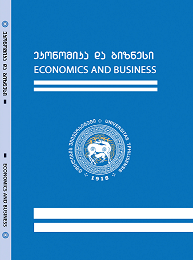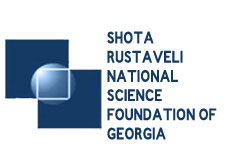
Referential and Reviewed International Scientific-Analytical Journal of Ivane Javakhishvili Tbilisi State University, Faculty of Economics and Business

The Subsistence Minimum in Georgia and the Necessity for Determining Its Optimal Level
Subsistence minimum is a kind of social reference, social standard of living used for fixing the amount of the wages, pensions, stipends, allowances and other social benefits. The full value of subsistence minimum consists of the cost of food products (the so-called “food basket”) required for a healthy and productive life of an able-bodied person as well as the minimum costs of non-food consumer products and services (at market prices). The population of Georgia has been malnourished for years, unable to purchase and consume relatively expensive products (meat, milk and dairy products, fish, fruits, vegetables) in accordance with the real physiological standards, and satisfied food demands mostly by cheaper products, such as bread, which represents almost half the ration of food, while in the developed countries, the share of bread in the ration is only 12-15%. Because of all this, for years, the population has been suffering from protein deficiency, as well as lack of viNew Methodology of National Accounts System and Peculiarities of Its Implementation
SNA is a combination of integrated macroeconomic accounts and balances based on internationally agreed concepts, classifications, and general accounting rules. Its methodological basis is the international manual SNA 2008, developed by the United Nations (UN), Eurostat, the International Monetary Fund, the World Bank and the Organization for Economic Cooperation and Development (OECD). EU countries have begun switching to the new SNA methodology in 2014. Armenia, Turkey, Ukraine and Belarus have also joined their ranks during 2014-2015. Nowadays, the SNA 2008 has been introduced in about 80 countries around the world, including Georgia, however, some countries, still follow the previous version of the National Accounts System (SNA 1993). Implementation of the new SNA 2008 methodology, with the active involvement of international experts, has been running in GEOSTAT since 2017. The transition to the SNA 2008 has led to a numberModern Content of Strategic Regional Development Potential
There are two spheres of modern potential of regional strategic development: a) structure and organization of the regional economy and management, b) productive recourses. Kinds of strategic regional potential are following: management potential, potential of trust, educational, productive, nature, innovative, human potential, potential of form and process. Principles of effective function of potential include conceptuality, empathy, utility and variety. Keywords: regional development, strategy, strategic regional management, strategic potential, components of strategic potential, principles of strategic potential. JEL Codes: R10, R11, P25, P48, Introduction The problem of choosing the path of regional development in modern conditions is directly related to the potential of strategic transformations of the regional economy. Explicit and latent components of the development potential give rise to strategic transformations, determine possible development vectors. Lack of developmentConspicuous Consumption and Philanthropy: Connections between Punjabi Immigrants from the Doaba Region and their Hometowns
Introduction This paper seeks to analyze the processes and practices of connections of first-generation diasporas from the state of Punjab, India to their hometowns in the Doaba region and consider the likely involvement of 2nd and 3rd generation immigrants in their ancestors’ birthplace. Indian Punjab has been one of the leading areas of emigration from India (along with the states of Kerala and Gujarat) in the 20th century. Estimates of the Punjabi population scattered across the globe varies from 1 million (Tatla, 2004) to 10 million (Ahmed, 2008). The region known as Punjab (Land of the Five Rivers) in the Indian subcontinent is composed of the terrain covered by the River Indus and its tributaries (Jhelum, Chenab, Ravi, Sutlej and Beas). The central area of Punjab is divided into three regions: Majha (land between the Ravi and Beas rivers), Doaba (between the Beas and Sutlej rivers) and Malwa (the area to the south and east of the river Sutlej). The DoabaReproductive Disposition of Georgian Students and Youth
After the collapse of the Soviet Union, in Georgia, as in the other former Soviet republics, a general crisis erupted that covered all aspects of life, including demographic relations. The birth rate has fallen sharply, meeting only the needs of short-lived reproduction. In 2018, about two times fewer babies were born than in 1990. Under such a regime of population reproduction, the generation of parents would have been replaced by a smaller number of children. There were years when the natural growth of the Georgian population was zero. Today, the demographic situation is slightly improved, but it takes many years to achieve the desired situation. The generation of parents is replaced by the generation of children in equal numbers. But such a regime of population reproduction is unacceptable for Georgia, whose population declined sharply in the post-Soviet period, from 1992 to 2018 (from 5.5 million to 3.7 million, or 32.7%). This is an alarming situation and such a decline in populatPrimary Care Gatekeeping and Referrals: Patient’s View on the Family Physician Role
An adequate primary healthcare system substantially determines quality of population health and effective spending of healthcare resources. The family physician serving as a ‘gatekeeper’ can make judicious decisions about the appropriate use of medical services. The goal of this study was to find out patients’ characteristics, preferences and behavior in regards to the role of the family physician as the gatekeeper in The Republic of Georgia. As part of a cross-sectional quantitative study, respondents were interviewed using a structured questionnaire. Majority of the respondents (53.7%, n=245) had a permanent family physician, but were not satisfied with a level of family physician’s professionalism (56.6%, n=258) and preferred self-referral to specialists (55%, n=253). Only 19.5% (n=89) referred to specialists upon family physician’s advice who would coordinate all services and 23% (n=103) have used both family physicians and self-referral. Private healtRisk Identification Peculiarities in Public Procurement of Construction Works
State-funded construction projects are implemented through public procurement in Georgia, in which the contracting authorities are governmental organizations and the suppliers are commercial organizations. According to the State Procurement Agency's annual report 2018, contractual value of tenders of construction works was GEL 1,734,667,834 in this year, which significantly exceeds the same figures for goods (GEL 717,837,509) and services (GEL 457,834,783). Due to the large scale of construction work, the risk factors are high, also, there is a high level of competition, the number of stakeholders, the estimated value and the bidding requirements. The most common risks in the procurement of construction works are the risks of competition because they are involved in the process both residents and non-residents. One of the indicators of the level of competition in public procurement is the average number of bidders participating in tenders. In 2018, the average pSome Aspects of Loan and Capital Financial Instruments
Financial Instruments are any contract that generates both the financial assets of one enterprise as well as the financial liability of the second enterprise or the equity instrument. In many cases, the contract does not clearly indicate what the enterprise has to do with financial liabilities or equity instruments. Emission and equity instruments are implemented in different conditions, which determine the actual economic content of the instrument. Their recognition, measurement and accounting procedures differ significantly, while their correct classification affects the financial indexes and the financial conclusions and decisions made by an user of the financial information. Thus, it is important to properly identify, measure and reflect in the financial statements all financial instruments. Keywords: Financial instruments, loan instruments, equity instruments, difficult financial instruments, option. JEL Codes: G10, G18, G21 Introduction When preparing the financiaSome Modern Trends in the Management of Commercial Banks
The scale of banks consolidation has taken on an unprecedented nature in recent decades. Large banks have much more opportunity to attract a long-term financial resources from the world capital markets, the qualitative and quantitative indicators of the bank created by the merger / absorption can be much better. On the other hand, absorption can be interpreted as a central element of the market-driven survival process, and the distinguishing criterion between absorbed or absorbing companies is the firm's size rather than the norm of profitability or market valuation. The 2008-2009 global financial crisis has led to the need to improve international standards for regulation and supervision in the financial sector. In 2014, Basel IV's revised standardized approach to market risk was published, focusing on three messages - 1. Risk; 2. Risk management; 3. Risk-oriented supervision. In addition, the present paper focuses on the importance of stress-testing on the external factors of the bEstimating Capital Stock and Return on Capital for Georgia
Acknowledgement: This work was supported by the Shota Rustaveli National Science Foundation (SRNSF) [N FR17_122, The Puzzle of Economic Development without Rural Urban Migration in Georgia] Abstract In this paper, we estimate capital stock for Georgia using the Perpetual Inventory Model (PIM). Due to data constraints, different techniques are used to estimate the model’s parameters. The model is based on public and private annual investment data from 1996-2017. Georgia’s Statistics Office doesn’t publish official capital stock data, a key variable in estimating aggregate production function which is essential for economic growth models, productivity analysis, and many other macroeconomic applications. Thus, our work will contribute to different macroeconomic models on forecasting and policy analysis for Georgia. The second part of the paper presents the calculation of return on capital using the newly constructed capital stock series and uses the rate of returThe Importance of Emotional Intelligence for Effective Leadership
This article discusses the importance of emotional intelligence for effective leadership. It first explains what emotional intelligence is and why it is important to improve it. There are described in detail the five key competences of emotional intelligence, namely: Self-awareness; Self-regulation; Social skill; Empathy; Motivation. The second part of the article discusses ways to develop emotional intelligence, in particular a five-step model that addresses the following questions: Who do I want to be? Who am I now? How do I get from here to there? How do I make change stick? Who can help me? Also, in aticle discusses other important issues related to effective leadership, for example How Resilience Works etc. Keywords:Management (M000), personnel management, leadership, motivation. JEL Codes: J53, M5, M54 ემოციური ინტელექტის მნიშნველობა ეფექტიანი ლიდერობThe New Context of Marketing in Social Media (Conceptual review)
This article is dedicated to the main powerful instrument of marketing – Social media, which altered the environment of marketing, customer’s habits and preferences. The growth of knowledge and experience gave customers more capability and power in the market. This article is based on more than 50 modern publications, websites and blogs. It particularly reviews conceptual aspects of social media marketing and influence marketing. Several surveys have been conducted in Georgia about social media marketing. Unfortunately, scientific work on influencer marketing is almost nonexistent. The work refers to the different steps of the development of digital marketing, the forms and modern methods of social media and influencer marketing. Both of them impact customer’s behavior, their attitude towards different brands and facilitate decision-makiMethodological Recommendations for Forming and Developing Priority Directions of Racha Rural Tourism
The European Union countries consider rural tourism development as one of the most relevant economic growth alternatives in poor and depressed regions. This field of tourism consumes diverse resources in rural and surrounding areas, therefore, rural tourism can be implemented in various ways. As a fact, the regions, which are rich with tourism resources, get an opportunity to meet the customer needs better and at the same time, get economic efficiency by broadly utilizing the resources in the household turnover. As a result, agrotourism is attracting field for the country such as Georgia. The majority of the research papers dealing with the problematic issues in rural tourism is based on the concept, that development of rural tourism depends on natural resources. We agree with the consideration that tourism as a multi-dimensional and intersecting socio-economic phenomena is based on using various resources while the efficiency of using tourism resources is based on the factors which eJournal "Economics and Business", 2019 N1-4
2019 N1 Article Authors List of Rubrics and Articles pp.N 2019 Cristmas Epistle of the Catolikos - Patriarch of Georgia Ilia II 9 ECONOMIC TEORY, ECONOMIC POLICY Elguja Mekvabishvili Deposits, Banks and “The Initial Accumulation of Capital” in Post-communist Georgia 16 Avtandil Silagadze Comparative Analysis of Some Economic Indicators of Post-Soviet Countries in the South Caucasus 36 Irakli Kovzanadze Georgia’s Agriculture Financial Support on the Modern Stage 39 Demur Sichinava Cryptocurrency – A Future Medium of Exchange 55 MICROECONOMICS, MACROECONOMICS, ECONOMETRICS Paata Koguashvili David Mamukelashvili Badri Ramishvili Cooperative Domestic Production Relationships – The Basis








